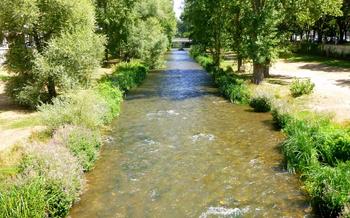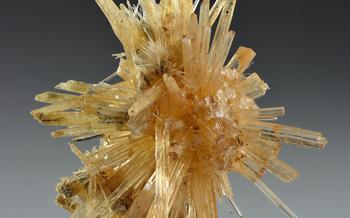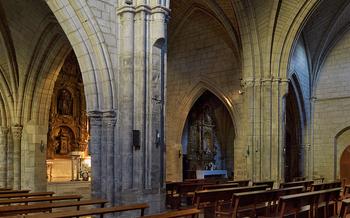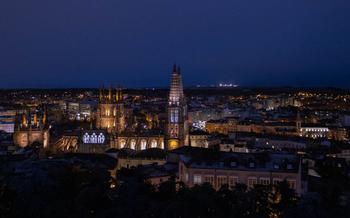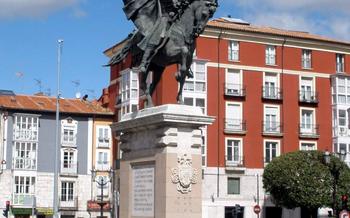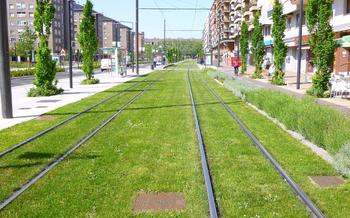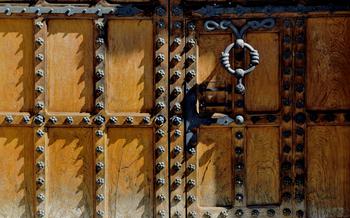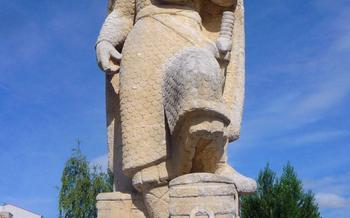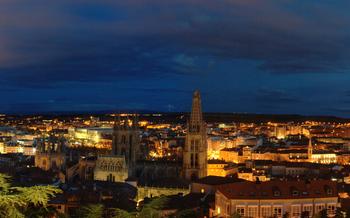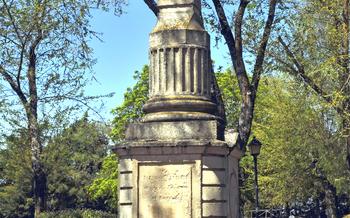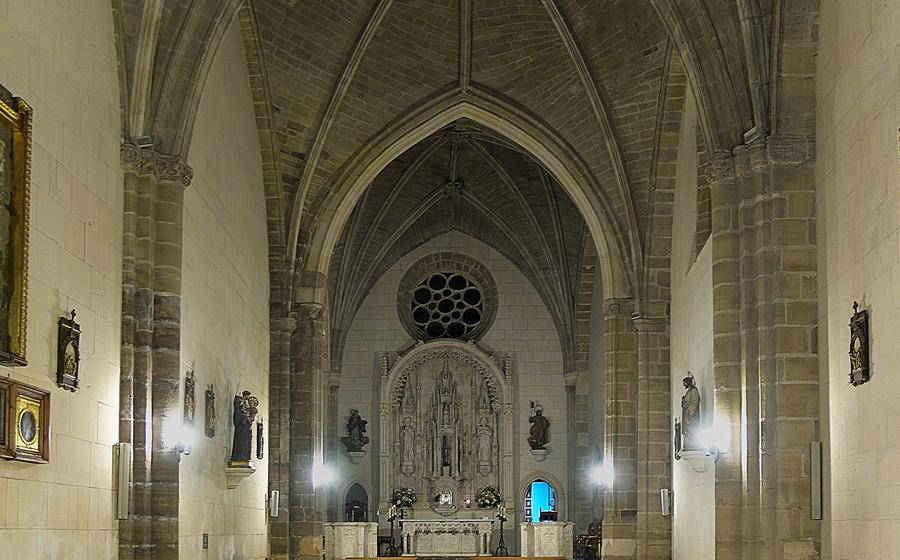
Iglesia de Santa Águeda
- Historical Significance
- Architectural Masterpiece
- Home to Artistic Treasures
- Immerse in Local Culture
- Walk Through History
- Attend a Mass
- Guided Tour vs. Self-Guided Exploration
- Photography Tips
- Plan Your Visit
- Learn About the Templars
- Step Back in Time
- Stay Hydrated
- Insider Tip: Hidden Chapel
Historical Significance
The Iglesia de Santa Águeda stands as a testament to the rich history of Burgos, deeply interwoven with the legacy of the Templars and the tumultuous events of the Siege of Burgos. Constructed in the 12th century, the church embodies the essence of Romanesque architecture, with its sturdy stone walls and intricate carvings. Its historical significance extends beyond its architectural beauty, as it was an integral part of the Templar history in the region and played a crucial role during the Siege of Burgos in 1475, when it served as a strategic stronghold for the city's defenders. Explore the church's hallowed halls, and let its ancient stones whisper tales of a bygone era, transporting you back to a time of chivalry, faith, and resilience.
Architectural Masterpiece
The architectural features of the Iglesia de Santa Águeda are a testament to the skill and artistry of its builders. The intricate carvings that adorn the exterior and interior of the church are a highlight, showcasing biblical scenes, mythical creatures, and floral motifs. The pointed arches, a hallmark of Gothic architecture, create a sense of height and drama, drawing the eye upwards towards the vaulted ceilings. These ceilings, adorned with intricate patterns and vibrant colors, add to the awe-inspiring atmosphere of the church. Each element of the church's architecture comes together to create a harmonious and visually stunning masterpiece that has stood the test of time.
UNESCO World Heritage Site in 1984 further solidifies its significance. The church's Gothic influence is evident in its pointed arches, ribbed vaults, and intricate stained-glass windows. While sharing similarities with other notable Spanish churches, such as the Cathedral of Burgos, the Iglesia de Santa Águeda maintains its own unique character. It embodies the harmonious blend of Romanesque and Gothic styles, making it a true architectural gem that attracts visitors from around the world.
Home to Artistic Treasures
The Iglesia de Santa Águeda is a treasure trove of artistic masterpieces that captivate visitors with their beauty and historical significance. The church's interior is adorned with gilded altarpieces, intricate Renaissance sculptures, and stunning stained glass windows, creating a visually stunning and awe-inspiring space.
The main altarpiece, crafted from gold-plated wood, is a masterpiece of the Gothic period, depicting scenes from the life of Christ and the Virgin Mary. The Renaissance sculptures, scattered throughout the church, showcase the exceptional skill and artistry of the period's sculptors, capturing the essence of human emotion and the divine.
The stained glass windows, with their vibrant colors and intricate designs, bathe the church's interior in a soft, ethereal light, transforming it into a sacred and serene space. These windows, meticulously crafted by skilled artisans, depict religious scenes and biblical narratives, adding to the church's spiritual atmosphere.
A visit to the Iglesia de Santa Águeda offers visitors the opportunity to admire a diverse collection of artistic treasures, each piece contributing to the church's rich cultural heritage and providing a glimpse into the artistic and religious traditions of the past.
Immerse in Local Culture
The Iglesia de Santa Águeda is not merely a historical and architectural marvel; it is also a vibrant hub of local culture and religious devotion. Throughout the year, the church hosts a variety of events that offer visitors a chance to immerse themselves in the traditions and celebrations of Burgos.
One of the most significant events is the annual Feast of Santa Águeda, held on February 5th. During this festival, the church is adorned with colorful decorations, and a solemn mass is held to honor the patron saint of Burgos. Locals gather to participate in the procession, carrying the statue of Santa Águeda through the streets accompanied by music and traditional dances.
The church also plays a crucial role in the Camino de Santiago, one of the most famous pilgrimage routes in the world. Many pilgrims stop at the Iglesia de Santa Águeda to seek blessings and pray for a safe journey. Visitors can witness the deep devotion of the pilgrims as they gather in the church to receive a special blessing before embarking on their pilgrimage.
In addition to religious festivals, the church frequently hosts cultural events such as concerts, exhibitions, and lectures. These events provide a platform for local artists and performers to showcase their talents and share their culture with the community. Attending these events is an excellent way to experience the vibrant cultural scene of Burgos and connect with the local people.
Walk Through History
Take a stroll through the labyrinthine streets that surround the Iglesia de Santa Águeda and let the whispers of history guide your footsteps. Burgos's medieval heritage is palpable as you wander past ancient houses adorned with intricate carvings, hidden courtyards that evoke a bygone era, and charming boutiques that showcase local crafts.
Explore the imposing medieval walls that once guarded the city, their weathered stones bearing witness to countless battles and sieges. These ramparts, with their strategic towers and fortified gates, offer a glimpse into Burgos's turbulent past when it stood as a bastion against invading forces. As you walk along the ancient walls, imagine the clash of swords, the thunder of cannons, and the resilience of the people who defended their city with unwavering determination.
Uncover hidden gems tucked away in the narrow alleyways, such as the Palacio de los Condestables, a stunning Renaissance palace that exudes elegance and grandeur. Or stumble upon the Casa del Cordón, a Gothic masterpiece with a captivating history intertwined with the Catholic Monarchs. Each corner of this historic quarter reveals a new treasure, waiting to be discovered by curious travelers who embrace the allure of the past.
Attend a Mass
Make your visit to the Iglesia de Santa Águeda even more meaningful by attending a religious service. Immerse yourself in the reverent atmosphere and connect with the local community as you witness the heartfelt devotion of the congregation. Participate in the prayers, hymns, and rituals, and let the spiritual energy of the church envelop you. Whether you are a devout believer or simply seeking a unique cultural experience, attending a mass at the Iglesia de Santa Águeda is an opportunity to gain a deeper understanding of the religious traditions and practices that have shaped this historic city.
Guided Tour vs. Self-Guided Exploration
Whether you prefer the convenience and insights of a guided tour or the freedom and flexibility of self-guided exploration, both options offer unique experiences at the Iglesia de Santa Águeda.
Guided tours, typically led by knowledgeable local experts, provide an in-depth understanding of the church's history, architecture, and artistic treasures. Listen to captivating stories and uncover hidden details that you might miss on your own. Guided tours often include access to restricted areas, such as the sacristy or the choir loft, offering a more comprehensive experience.
Self-guided exploration, on the other hand, allows you to set your own pace and focus on the aspects that most interest you. Wander through the church at your leisure, take your time to admire the intricate carvings and stained glass windows, and linger in the chapels that resonate with you. With a guidebook or smartphone in hand, you can learn about the history and significance of each feature at your own convenience.
Ultimately, the choice between a guided tour and self-guided exploration depends on your personal preferences and travel style. If you value in-depth knowledge and historical context, a guided tour is an excellent option. However, if you prefer the freedom to explore at your own pace and delve into specific details that capture your attention, self-guided exploration offers a fulfilling experience.
Photography Tips
The intricate details of the Iglesia de Santa Águeda provide ample opportunities for stunning photography. For the best results, visit during the golden hours of sunrise or sunset when the warm light casts a magical glow on the church's exterior. Inside, use a tripod and a wide-angle lens to capture the soaring height of the vaulted ceilings and the intricate carvings adorning the walls. Experiment with different angles and perspectives to create dynamic compositions that showcase the church's architectural beauty. Don't forget to pay attention to the interplay of light and shadow, as the changing light throughout the day can dramatically alter the mood and atmosphere of your images.
Plan Your Visit
To make the most of your visit to the Iglesia de Santa Águeda, it is essential to plan your trip effectively. Here are some practical considerations to keep in mind:
- Operating Hours: The church is generally open to the public daily, with specific hours varying depending on the season and special events. Check the official website or local tourist information centers for up-to-date information.
- Ticket Prices: Admission to the church is typically free of charge, allowing you to explore its wonders without any financial burden. However, certain guided tours or special events may require a fee, so it is advisable to inquire about pricing in advance.
- Accessibility Information: The church is accessible to visitors with limited mobility, featuring ramps and elevators to facilitate ease of movement. Additionally, guided tours specifically designed for individuals with disabilities are available upon request, ensuring an inclusive and enriching experience for all.
Learn About the Templars
The Knights Templar, a prominent monastic order of the Middle Ages, played a significant role in the history of Burgos. Their presence and influence in the city can still be felt through various historical sites and legends associated with the order.
The Templars initially arrived in Burgos in the 12th century, tasked with protecting pilgrims traveling the Camino de Santiago. Over time, they accumulated wealth and power, becoming one of the most influential religious orders in the region. They established a commandery in the city, which became a center for their activities and a symbol of their presence.
One of the most intriguing aspects of the Templars' history in Burgos is their alleged involvement in the Siege of Burgos. In 1358, King Pedro I of Castile besieged the city, intent on capturing it from his half-brother, King Enrique II. According to legend, the Templars played a crucial role in defending the city against the siege.
The Templars' presence in Burgos is shrouded in mystery and intrigue. Their commandery has long since disappeared, but their legacy lives on in the stories and legends passed down through generations. Visitors to Burgos can immerse themselves in this fascinating history by visiting the city's medieval quarter, exploring the sites associated with the Templars, and learning about their profound influence on the city's past.
Step Back in Time
Burgos offers a unique opportunity to step back in time and experience the grandeur of its medieval past. Throughout the year, the city hosts several historical reenactments, medieval markets, and traditional festivals that transport visitors to a different era. These events provide a glimpse into the lives and customs of the people who lived in Burgos centuries ago.
One particularly popular event is the annual "Cerco de Burgos," which reenacts the famous siege of the city by the Castilian army in 107During this event, the streets of Burgos are filled with people dressed in medieval costumes, and there are jousting tournaments, archery demonstrations, and other activities that bring the past to life.
Another highlight is the "Mercado Medieval de Burgos," a medieval market that takes place in the historic center of the city. Here, visitors can browse stalls selling handmade crafts, sample traditional foods, and enjoy live music and entertainment.
These events are a fantastic way to learn about Burgos's rich history and immerse yourself in its vibrant culture. Whether you're a history buff or simply looking for a fun and unique experience, be sure to check out one of these events during your visit to Burgos.
Stay Hydrated
Remember that Burgos's dry climate and the church's lack of water fountains can lead to dehydration, especially during summer. Avoid discomfort and potential health risks by bringing your own reusable water bottle. Staying hydrated will allow you to fully enjoy your exploration and appreciate the church's beauty without distractions.
Insider Tip: Hidden Chapel
Venture beyond the main sanctuary to uncover this secluded chapel unveils a tranquil ambiance, adorned with captivating frescoes that narrate biblical tales. Allow yourself to be mesmerized by the intricate artistry and immerse in the serene atmosphere, offering a moment of respite and reflection amidst the grandeur of the church.
